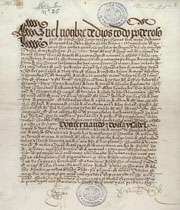Today in History:
The Treaty of Tordesillas (1494)

The Treaty of Tordesillas (Portuguese: Tratado de Tordesilhas, Spanish: Tratado de Tordesillas), signed at Tordesillas (now in Valladolid province, Spain), 7 June 1494, divided the newly discovered lands outside Europe between Spain and Portugal along a meridian 370 Castillian leagues (approximately 2,061 kilometres (1,281 mi)) west of the Cape Verde islands (off the west coast of Africa). This line of demarcation was about halfway between the Cape Verde Islands (already Portuguese) and the islands discovered by Christopher Columbus on his first voyage (claimed for Spain), named in the treaty as Cipangu and Antilia (Cuba and Hispaniola). The lands to the east would belong to Portugal and the lands to the west to Spain. The treaty was ratified by Spain (at the time, the Crowns of Castile and Aragon), 2 July 1494 and by Portugal, 5 September 1494. The other side of the world would be divided a few decades later by the Treaty of Zaragoza or Saragossa, signed on 22 April 1529, which specified the antimeridian to the line of demarcation specified in the Treaty of Tordesillas. Originals of both treaties are kept at the Archivo General de Indias in Spain and at the Arquivo Nacional da Torre do Tombo in Portugal.
Source: encyclopedia.thefreedictionary.com
Other Links:
Today in History: Mary Had a Little Lamb Published (1830)
Today in History: Six-Year-Old Etan Patz Abducted in New York (1979)
Today in history: The Last Supper Back on Display after Two-Decade Restoration (1999)